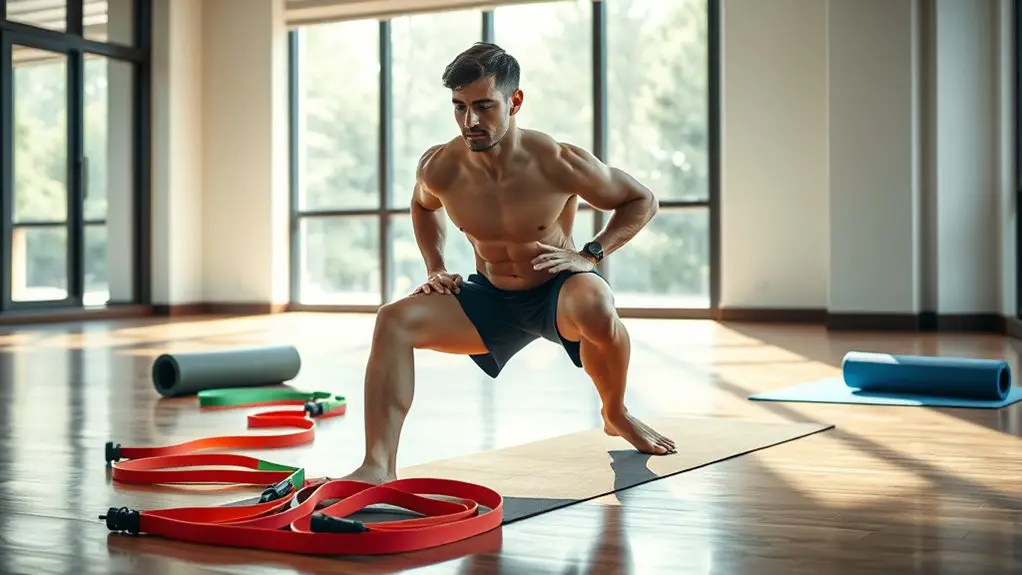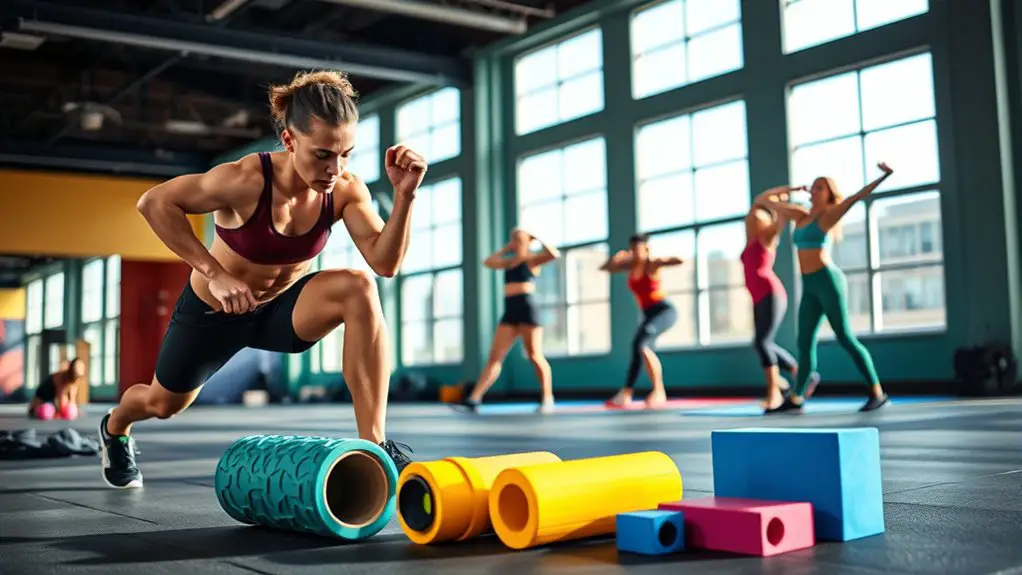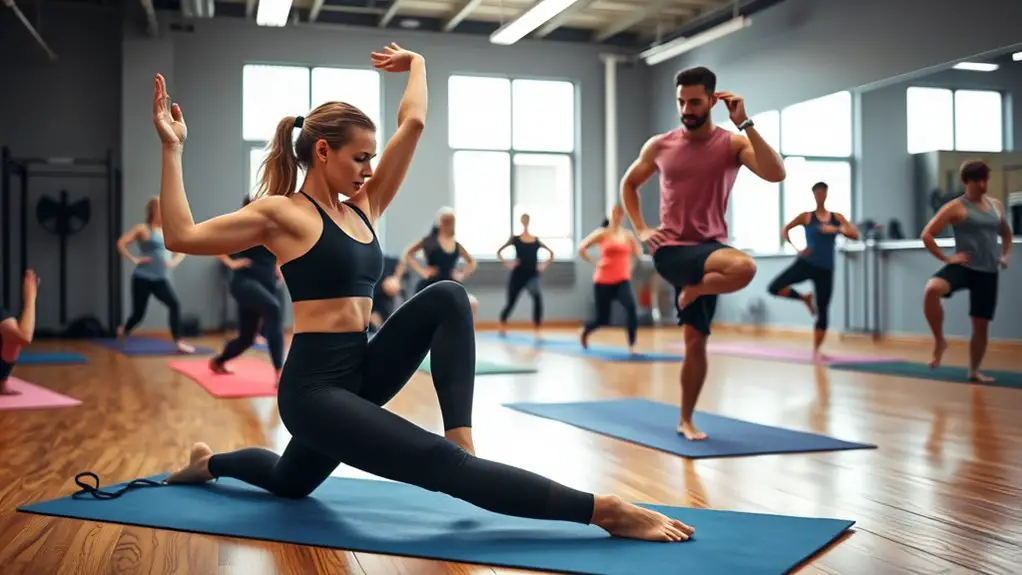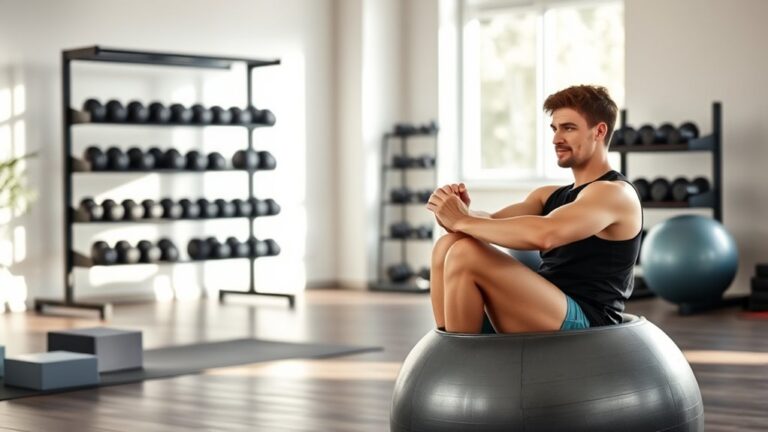The Best Mobility Drills to Improve Gym Performance

To improve your gym performance, it’s crucial to incorporate mobility drills into your routine. Dynamic stretching like leg swings and walking lunges can enhance flexibility and prepare your muscles for workouts. Foam rolling helps release tension and boosts recovery. For focused gains, include hip mobility drills and shoulder exercises like band pull-aparts. A consistent mobility practice reduces injury risk and optimizes movement efficiency. Keep going, and you’ll discover more effective strategies to elevate your fitness journey.
Understanding Mobility and Its Importance in Fitness

When you think about fitness, mobility often takes a backseat to strength and endurance, but it’s just as crucial. Many believe that mobility’s only purpose is to prevent injuries, but its benefits extend far beyond that. Improved mobility enhances performance, allowing you to execute movements with greater ease and efficiency. You’ll find that better mobility can lead to increased strength gains and faster recovery.
Unfortunately, mobility misconceptions can hinder your progress. Some think it’s just for older adults or those with existing injuries, but in reality, everyone can benefit from incorporating mobility work into their routine. It’s not about being flexible; it’s about maintaining a full range of motion to optimize your workouts. By prioritizing mobility, you’ll reveal your body’s potential, reduce the risk of injury, and enhance overall performance. So, don’t neglect this crucial aspect of fitness—embrace it!
Dynamic Stretching: Preparing Your Body for Movement
Dynamic stretching is a game-changer for your workout routine, helping to enhance flexibility and prepare your muscles for action. By incorporating effective techniques, you can maximize performance and reduce the risk of injury. Let’s explore how to seamlessly make dynamic stretching a staple in your fitness regimen.
Benefits of Dynamic Stretching
Incorporating dynamic stretching into your warm-up routine can considerably enhance your gym performance. It’s all about boosting your dynamic flexibility and preparing your muscles for action. Here’s a benefits overview that highlights why you shouldn’t skip it:
- Increased Range of Motion: Dynamic stretching helps loosen tight muscles, allowing better movement.
- Improved Blood Flow: It enhances circulation, delivering oxygen to your muscles for peak performance.
- Enhanced Muscle Activation: Engaging muscles in a dynamic way prepares them for the workout ahead.
- Reduced Injury Risk: Warming up with dynamic stretches lowers the chance of strains and sprains.
Make dynamic stretching a staple in your routine, and you’ll notice the difference in your performance and overall workout effectiveness!
Effective Dynamic Stretching Techniques
Kickstart your warm-up with effective dynamic stretching techniques that’ll get your body primed for action. These movements enhance your range of motion, improving your overall performance in the gym. Focus on exercises like leg swings, arm circles, and walking lunges. They’ll activate your muscles and increase blood flow, setting the stage for a successful workout.
Dynamic stretching not only warms you up but also helps you reap the benefits of flexibility, making it easier to perform complex movements with confidence. Incorporating these techniques into your routine can reduce the risk of injury and enhance your strength. So, before you hit the weights, invest a few minutes in effective dynamic stretching to maximize your gym gains!
Incorporating Stretching Into Routine
While you may feel tempted to jump straight into your workout, taking the time to incorporate dynamic stretching into your routine is essential for preparing your body for movement. Unlike static stretching, which can reduce muscle performance when done pre-workout, dynamic stretching enhances your range of motion and warms up your muscles.
Here are some dynamic stretches to contemplate:
- Leg swings to increase hip flexibility
- Arm circles to engage shoulder mobility
- Walking lunges for lower body activation
- High knees to boost heart rate and coordination
Foam Rolling: Release Tension and Improve Flexibility
Foam rolling is one of the simplest yet most effective tools you can add to your routine to release tension and enhance flexibility. By incorporating foam rolling techniques, you can target tight muscles, improve circulation, and promote recovery. This self myofascial release method helps break down adhesions and knots, which can hinder your performance.
Start with your calves and work your way up to larger muscle groups like your back and quads. As you roll, pause on tender spots and apply gentle pressure to loosen the muscle. Aim for 1-2 minutes on each area, and don’t forget to breathe deeply to encourage relaxation.
Consistency is key; include foam rolling in your pre- or post-workout routine for the best results. By making this simple addition, you’ll not only feel better but also enhance your overall gym performance, leading to greater gains and improved mobility.
Hip Mobility Drills: Enhancing Lower Body Performance

To boost your lower body performance, focusing on hip mobility is key. Incorporating dynamic warm-up techniques and targeted stretching can enhance your strength and flexibility, setting you up for success in the gym. Let’s explore how these drills can elevate your workouts and prevent injuries.
Dynamic Warm-Up Techniques
Incorporating dynamic warm-up techniques, especially hip mobility drills, can greatly enhance your lower body performance in the gym. These exercises boost dynamic mobility, preparing your muscles and joints for action. Here are some warm-up benefits you can expect:
- Increased blood flow to muscles
- Improved range of motion in the hips
- Enhanced coordination and balance
- Reduced risk of injury during workouts
Stretching for Strength
Dynamic warm-up techniques lay a solid foundation for your workout, but to truly enhance lower body performance, focusing on hip mobility through targeted stretching is key. Incorporating static stretching into your routine can greatly improve your flexibility and range of motion, which are essential for effective strength training. Hip flexor stretches, pigeon poses, and deep squats can help release tension, promoting better movement patterns. By dedicating time to these stretches, you’ll not only reduce the risk of injury but also maximize your strength gains. Remember, a well-mobilized hip joint allows for more powerful squats and lunges. So, make stretching a priority in your training regimen, and watch your performance soar. Embrace the benefits of improved hip mobility today!
Shoulder Mobility Exercises: Increasing Upper Body Functionality
Shoulder mobility exercises are essential for enhancing upper body functionality and overall gym performance. Improving your shoulder range of motion can lead to better lifting mechanics and reduced injury risk. Here are some effective exercises to incorporate into your routine:
- Shoulder Circles: Stand tall and make small circles with your shoulders, gradually increasing the size. This warms up the rotator cuff and increases blood flow.
- Band Pull Aparts: Using a resistance band, hold it at shoulder height and pull it apart, squeezing your shoulder blades together. This strengthens the upper back and promotes shoulder stability.
- Wall Angels: Stand against a wall and slide your arms up and down, keeping your elbows and wrists in contact with the wall. This enhances shoulder mobility and posture.
- Overhead Stretch: Reach both arms overhead and lean to one side, then the other. This helps lengthen the shoulder muscles and improve flexibility.
Incorporate these exercises, and you’ll feel the difference in your performance!
Incorporating Mobility Drills Into Your Workout Routine

Improving your shoulder mobility sets the stage for better overall performance, but it doesn’t stop there. To truly benefit, you need to incorporate mobility drills into your workout routine consistently. Start by conducting mobility assessments to identify areas that need improvement. This’ll help you tailor your drills to your specific needs.
Aim to integrate mobility work before and after your main workouts. Doing dynamic stretches as a warm-up prepares your muscles, while static stretches post-session aids recovery. Remember, consistency is key; set aside time for these drills each week.
You might even consider scheduling “mobility days” focused solely on these exercises. This not only enhances your flexibility but also contributes to injury prevention. By making mobility a priority, you’ll notice increased range of motion and improved performance in lifts and athletic activities. Stay committed, and you’ll reap the rewards.
Frequently Asked Questions
How Often Should I Perform Mobility Drills Each Week?
You should aim for mobility drills at least three to four times a week. By incorporating them into your weekly schedule, you’ll enhance your flexibility and prevent injuries. Consistency is key; even short sessions can make a difference. Try to dedicate 10-15 minutes each session, focusing on areas that feel tight. Remember, mobility frequency is essential for maintaining overall range of motion and improving your performance. Keep it up, and you’ll see results!
Can Mobility Drills Help Prevent Injuries During Workouts?
Yes, mobility drills can greatly aid in injury prevention during workouts. By improving your range of motion and flexibility, you reduce the risk of strains and sprains, allowing you to perform exercises more effectively. When your joints and muscles are well-prepared, your workout efficiency increases, letting you push harder and achieve better results. So, make mobility drills a regular part of your routine to stay safe and enhance your performance!
Are There Specific Drills for Older Adults?
Are you looking for effective ways to enhance mobility as you age? Specific drills for older adults can really help! Incorporating balance exercises not only improves stability but also boosts confidence. Joint flexibility is essential, so gentle stretches targeting major muscle groups can make a significant difference. Remember to start slowly and listen to your body. With consistency, you’ll feel more agile and active, empowering you to enjoy life to the fullest!
What Equipment Do I Need for Mobility Exercises?
To get started with mobility exercises, you don’t need much equipment. A foam roller’s great for releasing tight muscles and improving flexibility. Resistance bands are also essential; they provide varying levels of resistance and can enhance your range of motion. These tools are affordable and versatile, making them perfect for home workouts. Don’t underestimate their effectiveness—using them consistently can lead to noticeable improvements in your mobility and overall well-being!
How Long Should I Hold Each Stretch During Mobility Drills?
Imagine a tree bending gracefully in the wind; that’s how you should approach your stretches. For dynamic stretching, aim for quick, fluid movements, lasting about 10-15 seconds each. When it comes to static stretching, hold each position for 20-30 seconds, allowing your muscles to relax and lengthen. This balance between dynamic and static will keep your body flexible and ready, just like that tree swaying effortlessly, adapting to every challenge.





